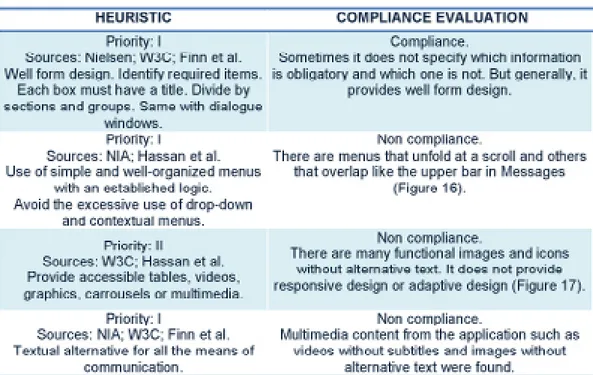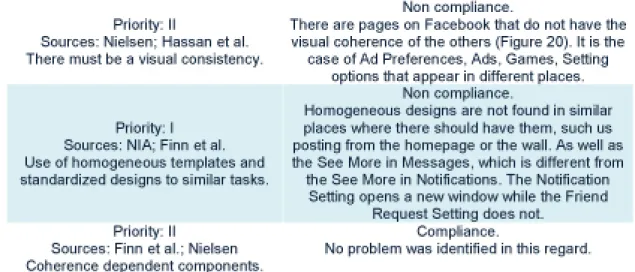Adapting usability heuristics to evaluate
Facebook according to elderly
Ivana Harari1 Javier Francisco Diaz2 Sandra Baldasarri3
oretical and practical foundations for the formal and objective observation of a product. One of the most used methods is the heuristic evaluation, a term coined by Jakob Nielsen in 1989, that consists of using a set of usability heuristics to exa-mine a product and analyze its degree of compliance. Due to the ever-growing use of Facebook by older adults, a heu-ristic evaluation of this application is car-ried out in this article, where principles of usability have been adapted to fit the profile of an older adult and the interac-tion with collaborative aspects and grou-pware functions that are characteristic of social networks. The results of this pro-cess of inspection will be of utmost im-portance to understand whether the cur-rent applications consider the older adult as a possible user, respecting principles of usability consistent with their profile.
Keywords: Human-Computer
inte-raction; Usability; User experience; User--centered design; Groupware.
ISSN: 2316-7963 ón formal y objetiva de un producto. Uno de
los métodos más utilizados es la evaluación heurística, término acuñado por Jakob Niel-sen en 1989, que consiste en utilizar un set de heurísticas de usabilidad para examinar el producto y analizar su grado de cumplimien-to. Debido al uso de Facebook cada vez mas extensivo por parte de adultos mayores, se realiza en este artículo una evaluación heu-rística sobre esta aplicación, donde principios de usabilidad han sido adaptados para adecu-arlos al perfil de un adulto mayor como a su interacción con las cuestiones colaborativas y funciones de groupware que caracterizan a las redes sociales. Resultados de este proceso de inspección será de suma importancia para entender si las aplicaciones actuales conside-ran al adulto mayor como posible usuario de las mismas, respetando principios de usabili-dad acordes a dicho perfil.
Palabras-clave: Interacción
Perso-na OrdePerso-nador; Usabilidad; Experiencia del usuario; Diseño centrado en el usuario; Groupware.
of people in the older adult age group is very high. It is believed that this community of adults will represent a 14% of the world population by 2025 and a 22% by 2050, that is to say that they will be one older adult for every five persons worldwide, when nowadays there is one for every eight persons (WHO, 2014).
Now, how do these demographic changes affect the field of computer science and computer network? Will this population considered by the WHO to be in the process of active aging, become the next users of our future applications? Are our software products designed for older adults?
This study focuses its attention in the usability evaluation of one of the most popular social networks in recent times: Facebook, which many older adults have recently started or are about to start using (Oldmeadow et al., 2013). It represents a favorable field to analyze whether this application has a usable and accessible design for older adult users. Besides its popularity, it is a software that creates tendency and sets paradigms that can be adopted by other social networks and products.
The usability evaluation based on inspection methods allows for the analysis of the applications’ interface in an objective and formal manner, through the eyes of HCI experts. It is important to learn about the applications in depth, to get acquainted before testing them with users, and also to consider beforehand whether or not they were designed with the older adult in mind.
In the case of the heuristic evaluation, which is the inspection method that will be carried out in this paper, the application is analyzed taking into account a set of recommendations, principles and guidelines, known as heuristics that establish how the interface should be designed. This allows the inspectors to be assisted in the pro-cess of research and detection of errors.
For this purpose, the heuristics applied in this article will be analyzed accor-ding to the user profile and the type of application, characterized by its collaborative and information sharing services. The results of the evaluation will be explained by showing the usability errors and the final conclusions.
2. In search of specific usability heuristics according to elderly and social network interaction
O Design Sprint é uma metodologia centrada no usuário, iterativa, prática e colaborThe ageing process can often result in elderly people experiencing multiple functional limitations like hearing loss, motor skill diminishment, vision decline or cognition effects (NIA, 2002). These limitations affect the way the interaction occurs, so specific usability guidelines must be considered by applications nowadays. The ol-der adult requires that certain design consiol-derations be taken into account in current applications to enjoy a quality-of-use interface. And this must happen with Facebook
In the first place, it is worth mentioning that in a groupware, the dialogue be-tween user and computer is still present. Therefore, the most popular usability re-commendations for single user interaction are still valid and will be contemplated in the set of heuristics.
However, several recommendations for groupware were taken into account in the evaluation. Primarily those that deal with the issue of concurrency from the perspective of the social interaction were there are concurrent activities from the members of the group, and simultaneous and multiple entries to a shared application (Hewitt and Gilbert, 1993). For the specific case of awareness, there are three im-portant aspects of groupware that should be analyzed: what information should be gathered and distributed, how the information should be presented to the group and when the information should be shown so as to be useful (Gutwin and Greenberg, 2016).
In this regard, combining the contributions of the most recognized authors in the field of usability in the different application areas and always taking into account the older adult, a comprehensive process of selection and integration of the most important recommendations and design principles proposed by them was developed in the area of usability in general, web usability and accessibility, specific usability for older adults and usability in groupware.
The set of heuristics that were built taking into consideration the older adult, were the result of the consideration of the following contributions in usability:
• Jakob Nielsen’s contributions for usability heuristics (Nielsen et al., 1993); • Hassan Montero and Fernandez’s contributions, specific for web usability (Has-san et.al, 2003);
• Adults usability checklist of NIA, National Institute of Aging (NIA, 2002); • W3C accessibility recommendations for older users (W3C, 2008); • Johnson and Finn’s Design Guideline for Older Adults (Finn et.al, 2014);
• Gutwin and Greenberg’s specific recommendations for groupware (2016), as well as Hewitt and Gilbert’s (1993).
Among all of them, the most appropriate ones were analyzed, selected and re-fined for the case study regarding elderly and groupware interaction. If we would like to examine an application that has mostly enquiry forms and widgets, we should find or develop a set of heuristics that is appropriate for such interactive components. In this particular case, since we are studying an specific collaborative web application and considering the profile of the older adult, we proceeded to analyze and adapt the recommendations that will be used to carry out the heuristic evaluation.
check boxes were discharged because they are not predominant components in the user interfaces of the web applications that are the focus of our study.
Unification Process. Principles have been combined from several sources to
make new ones. For example, Nielsen states that it is necessary to provide semantic feedback to distinguish the state of the system; Hassan Montero remarks that there must be a clear page structure; and on groupware, Hewitt states that the local area must be distinguished from the global one. From these contributions, a new principle was elaborated that establishes that there should be a clear design providing explicit feedback both on the local context as well as the shared one.
Synthesis Process. Several guidelines made it possible to form and constitute
one, taking into account the more specific one. For example, Nielsen states that a clear, distinguishable font must be provided, whereas the NIA recommendations su-ggest that the font size should be 12 or higher, Times New Roman font type, and that text should be expressed in an active voice. The latter being more specific than the previous one, was the one that was included.
Integration and Categorization Processes. The final adaptive heuristics were
grouped and integrated into nine different categories which allowed for a better or-ganization of the process of inspection and examination.
As the result of this adaptation process of the most important design principles, a set of 65 usability adaptive rules were derived. They were classified in order of prio-rity.
Priority in this case is based and proposed analyzing how much said recom-mendations affect the gulf of execution and evaluation in the interaction of the older adult with the application. According to Donald Norman, the gulf of execution is the cost that the user has in order to carry out his intentions in the system, while the gulf of evaluation is the cost that the user has in order to interpret the status of the system after the action [Hutchins et al., 1985]. A well-designed interface for older adults that respects usability guidelines should minimize both gulfs or distances in the interac-tion.
Each guideline according to its priority has a gradual rating of 1 to 3, in case it is complied. The following table describes these priorities:
Source: Elaborated by the authors according the research done
In the next section, the evaluation inspection will be explained in detail.
3. The heuristic evaluation applied to Facebook
The set of heuristics compiled in the previous section was applied in the usability inspection study conducted on Facebook. The application was explored in search for the compliance of 65 adapted recommendations.
The usability analysis is organized into the nine categories that will be explained in detail in the next sections. The evaluation results for each category are shown in tables. In each table it will be listed the selected heuristics with the priority that was assigned to it, the source(s) where such recommendation was taken from, whether it was complied with or not in Facebook and the usability problems found.
3.1 Heuristic analysis regarding presentation component
Table 2 shows the results of the heuristic evaluation regarding display features considering that the user interface design should guarantee to elderly the clear per-ception of the information that is being transmitted.
Source: Elaborated by the authors according the research done The figures mentioned in the Table 1 are:
Figure 1: Small fonts used in Facebook
Figure 3: Without images same options became inaccessible
Figure 4: Important sections and panels without titles or headings
Figure 5: Bad web content presentation in printable format
3.2 Heuristic evaluation about dialogue component
Table 3 shows the results of the usability inspection regarding simple and flexi-ble user-computer Interaction. The recommendations refined here point to the sim-plicity in the use of the application by elderly, as well as those that suggest that users should always have the control of the interaction.
Source: Elaborated by the authors according the research done
The figures for this category are:
Figure 6: See More option but without See Less option to close the expanded
Figure 7: Focus problems in the interaction with keyboard
Figure 8: No progress or estimated load time shown
Figure 9: Buttons do not work with Javascript disabled or an error page appears
Figure 10: Problems in the page when CSS is disabled
Figure 11: With virtual keyboards Facebook functions correctely
3.3 Heuristic evaluation regarding site structure and content
On this point 10 heuristics were compiled and refined to ensure that the appli-cation is built under a logical and simple structure of information and content appro-priate for older users. They include clear content sections, good content balance and distribution, and adequate level of information without saturation, absence or lack of information.
The results of the usability analysis regarding website structure and content is shown in Table 4.
Figure 12: panels with a lot of information without filtering and organization functions
Figure 13: Quick Help accessed from Profile page without information according to that context
Figure 15: Framework options that opens a new tab without a logo or other elements of the application to contextualize the user Table 5: Usability evaluation considering visual components and multimedia principles
Source: Elaborated by the authors according the research done
The figures mentioned here are:
Figure 17: Facebook does not provide responsive design
3.4 Heuristic evaluation regarding site structure and content
The usability evaluation regarding minimizing user memory load is shown in the Table 6 where 4 principles were formulated. The elderly user does not have to re-member where he is, and what were his last actions in the application. Adult users do not have to remember complicated syntactic mechanisms to perform a task. Neither, they do not have to remember data required by the system that can be recovered from the same system.
Table 6: Usability evaluation regarding minimizing user memory load
Figure 18: Example where no step-by-step instructions are given.
There is no information about how to filter message requests, the nor how to define and select the filtering criteria
Figure 19: Confusing transactions or options that have the same name but are dealt in different manner
3.6 Heuristic evaluation considering visual and terminological consistency
The evaluation of usability regarding visual and terminological consistency is ex-plained in Table 7. An effort must be made to not show/define the same information in different ways and vice versa, to not show/define different information in the same way, that would lead to unstable, confusing and operationally hampering situations.
Source: Elaborated by the authors according the research done
The figures of this section are:
performed by them or others.
There are 4 recommendations that aim to analyze this issue. The Table 8 will show the heuristic evaluation results regarding feedback.
Table 8: Heuristic evaluation according to visual and terminological consistency
Source: Elaborated by the authors according the research done
The figures mentioned in this section are:
red.
Table 9: Usability evaluation considering navigation principles
Source: Elaborated by the authors according the research done
Figure 22: Inconsistent titles of the link with the titles of the linked page
private and not a group activity.
The system cannot act as a black box, where the actions of the user as well as those of another member of the group, are processed without giving explicit indi-cations of what is being done, of the effects both local and global, or of the status resulting from such action.
The evaluation of Facebook taking account usability heuristics about groupware aspects, yielded the results shown in Table 10.
Source: Elaborated by the authors according the research done
The figures mentioned in this section are:
Figure 24: In the Like Panel the user doubts about which are the functions with global scope and which not
Figure 25: Without explicit indicators about the effect of actions over posts published by other in your Profile page. It is not clear for elderly which of the functions is a propagatable function and which is not
4. Results of the heurist evaluation process
The usability heuristic guide applied in the study, which was adapted for older adults and for their interaction with social networks, was very important. Allowed us to analyze the usability of a software product taking into account specific issues such
• 10 from 32 guidelines with priority 1 complied • 8 from 25 guidelines with priority 2 complied • 1 from 8 guidelines with priority 3 complied
The web application could have and ideal rating of 154 points if all of them are complied, since there are 32 heuristics of priority 1 that are assigned three points if they are complied, 25 heuristics of priority 2 that are assigned two points, and 8 heu-ristics of priority 3 that are assigned one point as is explained in Table 1.
In this case, Facebook has 47 points from that 154 total points, a 30,51% of usa-bility considering the adaptive heuristics developed.
Although it has been evaluated with a particular set of usability rules, the results show usability problems that would lead to future problems of interaction, use and learning by older users.
5. Conclusions
A new challenge arises nowadays for web developers where older people have to be incorporated as potential users of web applications that are complex in their dynamism, multiuser participation, collaboration services and sharing. This becomes even more difficult when older users access these resources and makes us question how current applications are being developed and if they are designed considering this community of users.
For this purpose, this study describes a process of usability inspection of one of the most popular social networks, that is, Facebook. The ever-increasing approach by an age group in society that is made up by people of a third or fourth age, to the use of this social network is the reason behind this study.
This is motivated by the need for researches that account for and evaluate whe-ther these applications are being designed to provide a quality of interaction to a user with these characteristics. In order to achieve this, heuristics from important authors in HCI literature were gathered, integrated and adapted according to the profile of the older adult and the type of application, which is a collaborative application or groupware.
According to a specific set of heuristics, this evaluation led to unsatisfactory results with regards to usability, taking into account that is an important and popular application that influences and modifies the future user interfaces design. It has been proved that despite their popularity, they present important usability problems; they do not comply with recommendations that must be observed and considered in fu-ture versions of web development because they not only affect young users but also
FINN, Kate and JONHSON, Jeff. Designing for Older Adults: Usability
Considera-tions for Real Users. www.wiserusability.com/author/adminjeff/, 2014.
GUTWIN, Carl and GREENBERG, Saul. Implications of We-Awareness to the Design
of Distributed Groupware Tool”. Journal, Computer Supported Cooperative Work,
25:279-293. Springer, October, 2016.
HASSAN MONTERO, Yusef and FERNANDEZ MARTIN, Francisco. Guía de Evaluación
Heurística de Sitios We”. NSU- No Solo Usabilidad. Nro.2, 2003.
HEWITT B. y GILBERT G.N. Groupware Interfaces. En CSCW in Practice: an Intro-duction and Case Studies. Editorial Springer Science & Business Media, 1993.
HUTCHINS, Edwin; HOLLAN, James y NORMAN, Donald. Direct Manipulation
In-terfaces. Human Computer Interaction. Vol.1. Lawrence Erlbaum Associates, Inc.
University of California, San Diego, 1985.
NIA- National Institute on Aging. Making your website senior friendly. National Li-brary of Medicine, USA, 2002.
NIELSEN, Jakob. Usability engineering. Academic Press Inc., Boston, 1993.
NORMAN, Donald y DRAPER, Stephen. User Centered System Design: New
Perspec-tives on Human-computer Interaction. Lawrence Erlbaum Associates Publishers,
Londres, 1986.
OLDMEADOW, Julian; QUINN, Sally and KOWERT, Rachel. Attachment style, social
skills, and Facebook use amongst adults. Journal of Computers in Human Behavior
29. Elsevier, 2013.
W3 Consortium. Web Accessibility and Older People: Meeting the Needs of Ageing
Web Users. Education and Outreach Working Group (EOWG), related to the
WAI-A-GE, 2010.
WHO- World Health Organization. World Health Stadistics Report. Ginebra: WHO Press, 2014.









